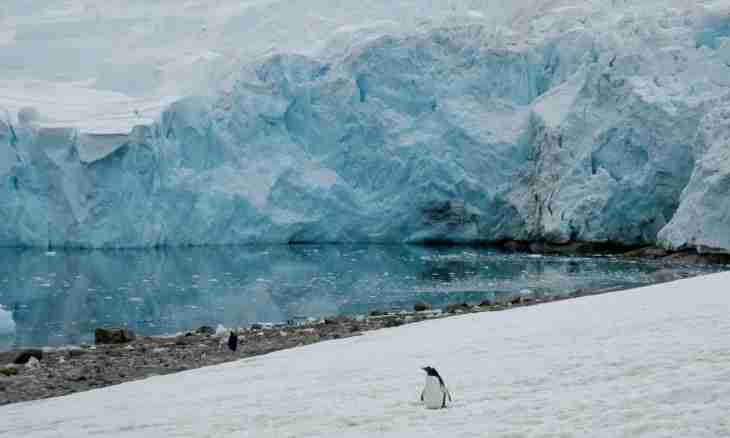In Antarctica there is a lot of cold, winds and ice. Especially there is a lot of ice. For this reason the southern continent is the highest in the world. It as well is the coldest: in 1983 recorded temperature of-89.2 °C. And polar day and night last for months.
General information
Antarctica is the continent surrounding the South Pole, is south of the Antarctic Circle, without overstepping its bounds.
Occupying only 10% of the Earth's surface, Antarctica has very large reserves of ice: about 90% of total amount of ice of our planet. If to express this number as a percentage of fresh water, then about 75% of all drinking world water will turn out.
The area equals 13,975 thousand sq.km. Here also ice shelf, the adjoined islands and glacial domes enter; their joint area is equal to 1582 thousand sq.km. But if to consider also a continental shallow, then will leave that all territory of Antarctica is located on 16355 thousand sq.km.
Almost all coast have the form of glacial break at which height reaches several dozen meters.
In the direction of South America Antarctic Peninsula on which there is a cape of the Prime – the most northern place of the continent was extended.
Heights and mountains
Antarctica is considered the highest continent in the world. Average height on it 2350 m while the average height of land of our planet is equal to about 900 m. Such indicators are explained by availability of ice which density is almost three times less than density of rocks.
Except glaciers on the continent there are mountains. The system of ridges dividing it into two parts is called as the Transantarctic Mountains. The point of Antarctica, most remote from the earth's surface, is Mount Vinson at which height reaches 5140 m.
In Antarctica the most southern settled down in the world an active volcano – Mount Eribus on the island of Rossa.
Ice – richness of Antarctica
Ice occupies almost all territory of the continent. Only 0.3% of land are free from ice. Ice is so thick that under it the whole mountain areas disappear. In some places it is possible to see several peaks which act over the surface of ice. Such ledges are called nunataka.
The age of some ice covers and layers reaches to one million years.
In the countries, for example in the UAE where are in clear fresh water in great need, projects on delivery of icebergs by the sea from Antarctica are developed.
The statement "Ice – it and in Africa ice" is at least wrong. As Eskimos for designation of snow have about 50 various names, and ice objects in Antarctica have several names, depending on the parameter in which ice is characterized.
Strong ice is called ice in a firm state which stuck to the Antarctic land.
Shelf ice – such ice which forms a ridge more than 2 meters high above sea level.
If in water several ice floes float at the same time, then call such mix pack ice.
Razvodye – pass through pack ice on which can float the ship without big difficulties.
The small space in open water surrounded with ice is called as an ice-hole.
The Antarctic convergence call a point in which colder water from Antarctica meets warmer subantarctic water and flows under it. Position of convergence can change at a size up to 100 km.
Climate
Climate in Antarctica severe at the expense of the blowing strong winds and low temperatures. Temperature can fall to the winter period below -70 °C. The minimum temperature ever recorded on Earth by means of contact thermometers was here on July 21, 1983, and equaled-89.2 °C. Much later began to say that allegedly "recorded" lower indicator of cold, but when using data from the satellite. And such method of measurement not the most reliable and not all approved.
In the areas which are about the center of Antarctica there can pass within several months polar night and polar day.

